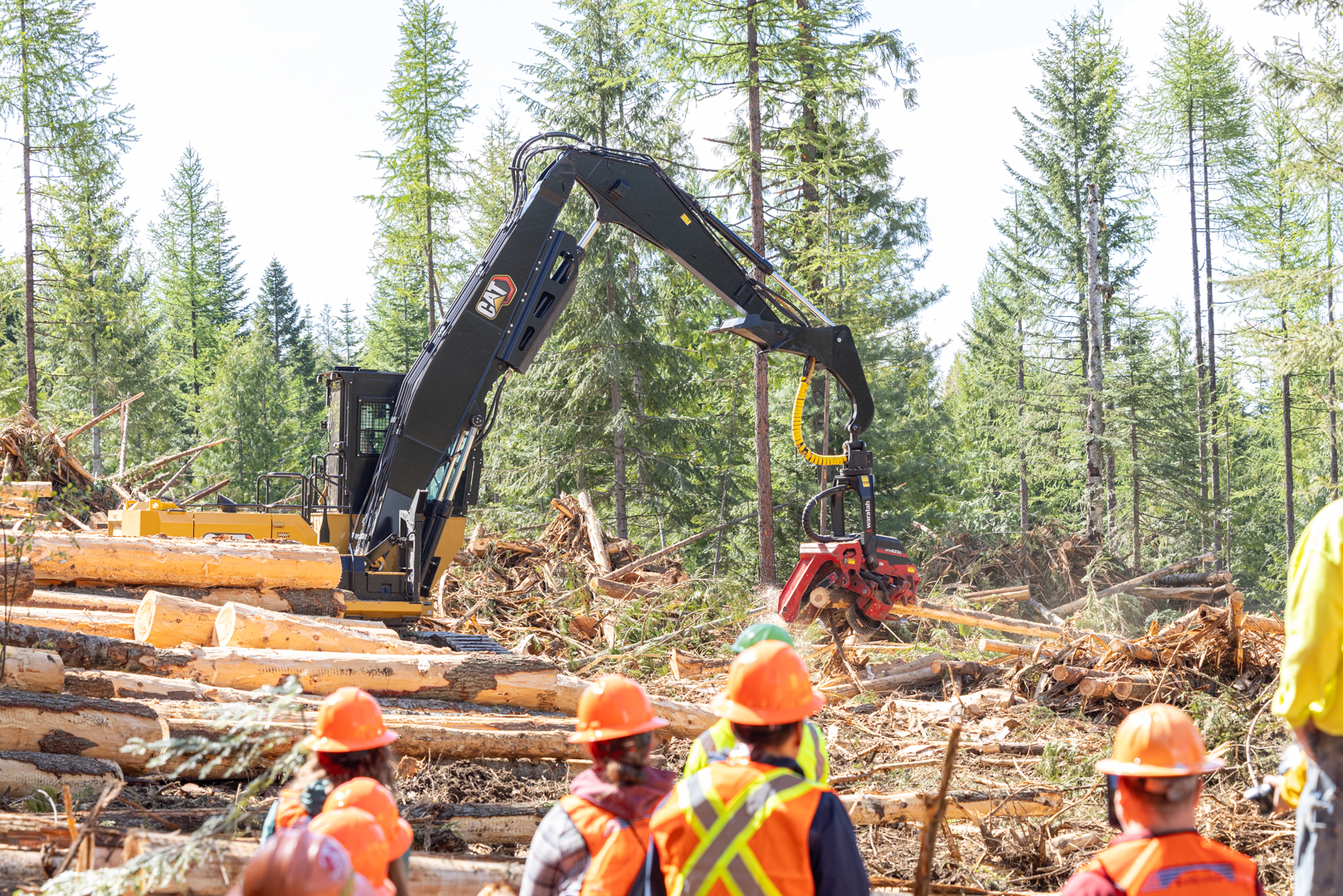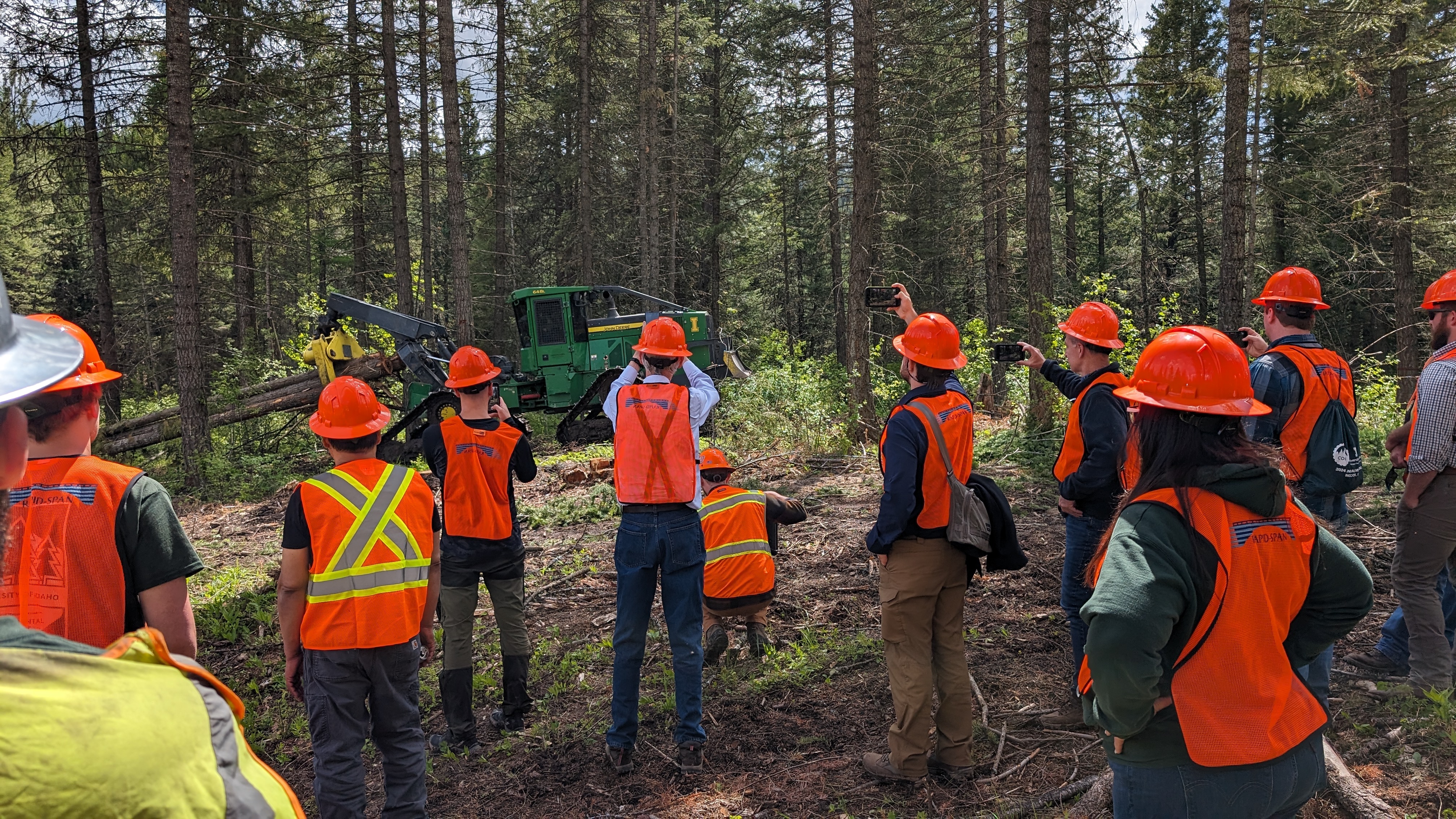COFE – The Future of Forest Operations
Posted on byWhat does safety have to do with forest engineering? Everything.

For the first time, Safety, Health, and Workforce Development was highlighted as a distinct track at the Council on Forest Engineering’s (COFE) Annual Meeting. Hosted by the University of Idaho’s College of Natural Resources and the University of Idaho Experimental Forest on May 21-24 in Moscow, Idaho, and co-sponsored by the NIOSH Agricultural Center, Pacific Northwest Agricultural Safety and Health (PNASH) Center, the meeting included attendees from across North America and Europe.
As one attendee put it, the conference was ‘inspiring.’ To bring in those of you that missed this conference, this blog shares some highlights. Additionally, stay tuned to the NIOSH Science Blog for a series of blogs sharing results from several NIOSH-funded forestry safety projects.

COFE blended traditional presentations with daily field excursions. Picture this… a convoy of vans bravely traversing logging roads on the UI Experimental Forest and neighboring forest industry lands. Engineers and safety researchers seeing felling equipment tethered down steep slopes to cut and process trees, without using chainsaws. A new skidder as large as a house with quad tracks rather than wheels that give it a lower center of gravity while also reducing impacts to soil (see photo at left). These technologies keep workers out of harm’s way. A tailgate safety demonstration of new technologies to improve situational awareness at the jobsite by showing where ground workers are in the forest in real-time and providing feedback about key health and safety hazard metrics from smartwatches.
This year’s conference theme was The Future of Forest Operations. Dr. Robert Keefe, a NIOSH grant project Principal Investigator and the conference chair, spoke to this theme during the opening remarks at the Idaho Central Credit Union Arena, a new mass timber facility built from Idaho forest products. Dr. Keefe discussed the business drivers underlying current trends in our field and encouraged participants to think about how technological innovation can assist at the intersection of improved productivity, worker health and safety, and workforce development needs facing our industry. The conference considered examples of technological innovation that are shaping the present to inspire creativity, collaboration among different research groups, and strategic foresight as we look to the future. There are several grand research challenges that shape the growth of smart and digital forestry, and these were woven into the conference. As we solve some and get closer to solving others, innovation is moving at a faster and faster pace. Recent advances and key challenges ahead include:
- Forest researchers around the world have recently overcome the challenge of mapping individual trees over large, mixed species forests using remote sensing tools like lidar.
- Can we use Low Earth Orbit Satellite (LEOS) networks like Starlink or other ad-hoc networks to connect data from both equipment and people in the woods to improve productivity, efficiency, and worker safety as part of an integrated system to support digital transformation in the forest industry?
- How can we improve the accuracy of the Global Navigation Satellite Systems (GNSS) under forest canopies to know with high accuracy where equipment and people are located at the jobsite to improve situational awareness and reduce accidents? This is also needed for teleoperation and – eventually – automation of equipment in forestry in the same way that precision guidance of tractors has been the norm in agriculture for many years.
- Once new data are available and being shared at the jobsite using data networks in remote areas, how can we use Artificial Intelligence (AI) to help forest workers and equipment operators make improved decisions at the human-machine interface to advance forest management and improve occupational safety and worker health?
Smart Forestry is a rapidly developing field, building on new technologies including use of ad-hoc data networks at remote jobsites, lidar- and other remote sensing tools for high-resolution forest mapping, improved GNSS connectivity, wearable devices with biometrics, ‘Internet-of-Things’ devices connected to heavy equipment, and AI. These were highlighted in the field during three days of demonstrations on the UI Experimental Forests and Pitkin Forest Research Nursery, including various field research projects led by faculty, graduate, and undergraduate students.
COFE is coming to NIOSH-land, Morgantown, West Virginia
COFE leadership hope to continue the integration of sessions on Safety, Health, and Workforce Development in future conferences beginning with the next one planned in Fall 2025 in Morgantown, West Virginia at West Virginia University.
COFE offers an inspiring model for participatory academic research. Membership and meetings include industry collaborators in research and actively encourage student participation in presenting their mentored research. While participants presented a wide array of research on forest operations business and other topics of interest from across the United States and the world, the event featured and highlighted the University of Idaho campus and its unique landscape, interagency and tribal partnerships on forest management, the Idaho Workforce Development Council and Idaho Career Ready Students program, and extensive experiential learning opportunities for undergraduates studying forestry and forest operations.
Where can you learn more?
Published abstracts are coming soon as is a special issue of the International Journal of Forest Engineering.
In the coming months read a series of NIOSH blog posts featuring NIOSH-funded forestry safety research.
Please learn more about this work and join this industry in addressing needs of forestry workers. With new climate pressures and fuels reduction activities, we need to collaborate for sustainable forests and communities.
Marcy Harrington, MPA, is the Senior Research Coordinator for the Pacific Northwest Agricultural Safety and Health Center, a NIOSH-Agricultural Center, based at the University of Washington Department of Environmental and Occupational Health Sciences.
Robert Keefe, PhD, is Associate Professor of Forest Operations at the University of Idaho Department of Forest, Rangeland, and Fire Sciences, and Director of the UI Experimental Forest at University of Idaho.
Jennifer Lincoln, PhD, CSP, is the Associate Director of the NIOSH Office of Agriculture Safety and Health.
Kitty Hendricks, MA, is a Research Health Scientist for the NIOSH Division of Safety Research and the Assistant Coordinator for the NIOSH Agriculture, Forestry and Fishing Program.
See the other blogs in this forestry series:
Posted on by

